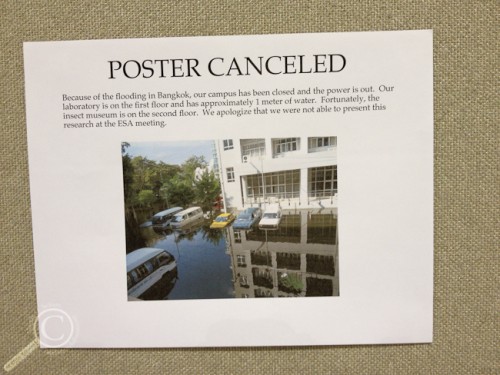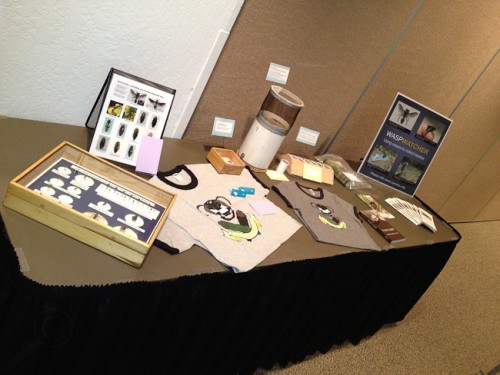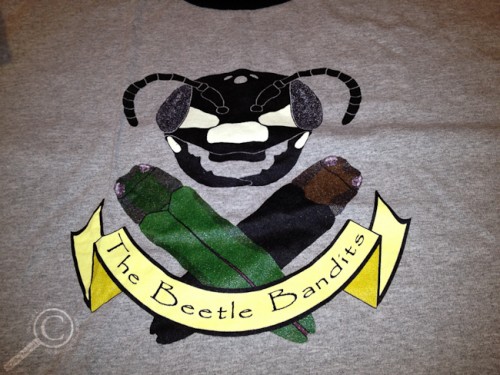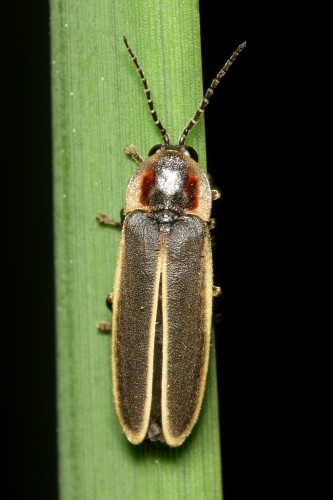 While working on my MSc in Ottawa back in 2008, my wife-to-be and I decided it would be appropriate to celebrate Canada Day on Parliament Hill with thousands of our fellow Canadians1. After spending a beautiful day taking in our country’s history with a full range of festivities including the RCMP Musical Ride, a stellar concert series that ran all afternoon, and speeches by politicians and other notable Canadians, we settled on the main lawn in front of the Peace Tower for an evening concert series and some killer fireworks. Continue reading »
While working on my MSc in Ottawa back in 2008, my wife-to-be and I decided it would be appropriate to celebrate Canada Day on Parliament Hill with thousands of our fellow Canadians1. After spending a beautiful day taking in our country’s history with a full range of festivities including the RCMP Musical Ride, a stellar concert series that ran all afternoon, and speeches by politicians and other notable Canadians, we settled on the main lawn in front of the Peace Tower for an evening concert series and some killer fireworks. Continue reading »
You may have noticed the Weekly Flypaper has been missing the past two weekends. I have a good reason for missing one, and a not so good reason for missing the other…
First, the good reason. I took part in the Rouge Park BioBlitz in Toronto, and along with 230+ other naturalists, taxonomists and volunteers, we scoured Rouge Park (soon to be Canada’s first urban National Park) for all signs of life, trying to identify as much as possible in 24 hours. Although the numbers are still coming in, the official species count is already nearing 1,300 species, all sighted or caught in 24 hours (and more than 800 of those were identified within the first 24 hours too)! That is an absolutely amazing number, and sets the bar very high for future BioBlitzes! The Guelph crew had a great time, and I think we contributed almost 100 insect species identifications, including 60+ flies. Lots more came home with us, and we’ll be getting names on them in the near future to be added to the list. The arthropod coordinator, Antonia Guidotti of the Royal Ontario Museum has posted an awesome synopsis of the BioBlitz over at the ROM Blog.
The other reason? I was lazy last weekend and didn’t get around to doing it. Oops.
So with 3 weeks worth of links, and major holidays upcoming in Canada & the USA, I suggest you grab a cold drink, find a comfy spot, and clear your schedule, because the Bugosphere has been busy! Continue reading »
This has been a very busy week for insect news & science, and there are a ton of great things to keep you busy reading all weekend. First though, I need to get something a little broader but incredibly important off my chest.
Prime Minister Stephen Harper’s War on Environmental Science
I don’t normally wade into discussing politics because 1) I don’t follow it as closely as perhaps I should and, 2) it can be a pretty controversial topic which can get messy in a hurry. I don’t want to weigh this week’s flypaper down too much, but I feel compelled to share a number of deeply concerning developments in the Canadian government’s recent cuts to environmental research.
If we’re not studying the affects of pollution on freshwater ecosystems, I guess we can still keep track of pollutants in marine environments. Wait, you mean that entire department has been cut as well? Oh. (As a slightly ironic aside, even the US media is picking this one up and questioning what the hell Canada is thinking)
Well, certainly our protected terrestrial environments will be studied and Canadian National Parks kept safe. No?! You have got to be kidding me. (It’s not only the natural history aspects of Parks Canada getting cut, it’s also our cultural history.)
Add to this the thousands of jobs cut across the Canadian Food Inspection Agency, Agriculture & Agri-Food Canada, Environment Canada, Public Health Agency of Canada and Health Canada, and it’s not hard to see that our current government views scientists & environmental research as an inconvenient truth (especially when they don’t tow the party line).
I’m incredibly proud to call Canada my home & native land, but am utterly ashamed of these “cost saving” measures being rapidly pushed through by the Conservative government. These short-sighted cuts will have long-lasting environmental ramifications well beyond the tenure of any political party’s leadership, will tarnish Canada’s reputation as an environmentally-friendly nation, and will hamper our ability to attract new minds to our universities, industries and governments. I have no doubt that in 10-15 years we will look back on this government and wonder “O Canada, what have you done?”
————
OK, that’s enough doom and gloom for one week. Now onto some bug links!
General Entomology
What would you classify angels as? If you said winged humans, you’re wrong. Clearly they’re insects. And in case you’re interested, the Taxonomy Fail Index for such a gaff is 122.3!
Tardigrades are pretty awesome, but this plush tardigrade by the Weird Bug Lady is way beyond cute!
Ani of Wanderer’s Eye documented the insect fauna of the Northwestern Ghats in India during last year’s monsoon season, and has put together an absolutely stunning e-book/slideshow. Amazing first step to documenting the insects of this poorly studied area; a must read!
Most people are familiar with entomopathogenic fungi in agricultural or tropical ecosystems, but what about in the Arctic? Chris Buddle explains why it’s important that we start learning about it soon.
Not shocking, but enlightening: city street lighting is changing the guild ecology of arthropods.
The Dragonfly Lady has 5 possible reasons why insects are so scarce in the ocean. I tend to follow the “Crustaceans were here first” line of thinking, but some of the other hypotheses are intriguing.
I’m not sure how I hadn’t heard of this project until now, but DrawWing aims to provide insect identifications via automated wing vein comparative analysis. Here’s some more info if you’re interested.
Diptera
It must be nearly summer, the stilt-legged flies are out and about again! Nice pictures of Rainieria antennaepes by Dave Stone at Things Biological.
Debbie Hadley at About.com Insects has a fun ID challenge this week. Think you can solve it?
How many flies are too many in a public bathroom? If you’re in Beijing, apparently 3…
One day I will make it to New Zealand and observe the caves of glow worms myself. Absolutely amazing spectacle, and something I can’t wait to see.
BugGuide.net is an awesome resource for North American insect lovers, and a big reason for that is the willingness of professional taxonomists like Terry Wheeler to contribute their time and knowledge to curating submitted images.
I suppose this great interview of Mohamed Noor is more about academia and evolutionary biology, but he uses fruit flies other than Drosophila/Sophophora melanogaster so I’ll leave it here in the fly files!
Hymenoptera
Bug Girl keeps the heat on the CCD-pesticide-bee health debate.
If you think all bees live in hives and produce honey, you’d best read this excellent primer on solitary bees by Africa Gomez at BugBlog.
Coleoptera
Ted MacRae has a touching tribute to Chuck Bellamy, a world-renowned expert in jewel beetle (Buprestidae) taxonomy, and the latest honorary member of the Coleopterists Society.
A genus of jewel beetles (Melanophila) have infra-red sensing organs more sensitive to forest fires than most man-made devices. Hot stuff!
Warning: this next link contains graphic images of beetles in compromising positions. What are they doing? You’ll just have to click to find out…
Lepidoptera
A lot is said about new digital cameras and their increasingly huge megapixel counts, but BunyipCo shows off the potential for entomology that a high megapixel camera can provide.
Arachnida
Earlier this year, major bank JP Morgan Chase suffered a multi-billion dollar financial meltdown, and it was just revealed that one of the leading causes was the chief executive being out of the office for significant amounts of time while she received treatment for Lyme Disease.
Another week, another stunning photo of a spider. This time by Rick Lieder at Bug Dreams.
Taxonomy/Biodiversity
This past Thursday was Carl Linnaeus’ 305 birthday, and the Biodiversity Heritage Library has a nice biography and a special download gift to help celebrate.
Natural history collections are a wealth of information, but sometimes that information comes in poorly appreciated packages. Like bottles of bird stomach contents cared for by an entomologist.
Other Fun Stuff
Scientific illustration meets comic book hero anatomy. Wicked anatomical drawing by Glendon Mellow.
 So it turns out you can perform your own backyard DNA extraction using only the ingredients you’ll find in a strawberry daiquiri served in a soapy glass…
So it turns out you can perform your own backyard DNA extraction using only the ingredients you’ll find in a strawberry daiquiri served in a soapy glass…
And now for a little etymological history. Ever wonder how those naughty little four letter words came into such infamy (or retreated from it)? Or why a question mark is squiggly while an exclamation mark is straight?
Finally, check out this great video about becoming a naturalist in your own backyard by the crew at Days Edge Productions. I loved every second of it!
Further Reading
I come across a large number of interesting blog posts, news articles, scientific papers and various other types of media every week, which I try and share through Twitter on a regular basis. Since I know not everyone has been bitten by the Twitter bug yet1, I figured I’d start a weekly round up of links to some of the stories I find interesting, important or just plain entertaining.
True to form, most of these links will be insect related, but I have broad interests, so some other topics are sure to turn up from time to time2. The internet is full of talented people, and I hope you enjoy their work as much as I have.
The Flies (Diptera)
The 8th International Congress of Dipterology is coming up in a few years, so be sure to start saving your pennies for the trip to Potsdam, Germany!
I prefer studying flies (dead or alive), but if that’s not your thing, check out these creative photos of dead house flies and blow flies having the times of their (already finished) lives. Here’s the full collection by photographer Nicholas Hendrickx.
The BugBlog has a nice series of photos of Helophilus pendulus, commonly called the Footballer Hoverfly in the UK. Why call it that, you might ask? Apparently the striped patterns on the thorax reminded someone of a soccer jersey.
The Dragonfly Lady shows off a nice hilltopping site in Arizona. Plenty of fly talk in the comments.
The Beetles (Coleoptera)
The Edmonton Journal has a great biography of Dr. George Ball, a beetle taxonomist at the University of Alberta who has impacted the careers of dozens of top entomologists across North America.
This short film is both beautiful and bizarre all at once. A stop-motion portrayal of the life of a beetle taxonomist who makes the discovery of a lifetime.
Emerald Ash Borer (Agrilus planipennis) has now been found in most major urban centres across Ontario, and has recently turned up in Quebec. Chris Buddle discusses the affect that EAB will have on Montreal.
While not EAB, Chrysobothris vivida looks quite similar on first glance. The Field Museum shows off the holotype and label data, helping to explain the role that natural history collections play in day to day science.
Speaking of natural history collections, a volunteer at the Natural History Museum in London, England shares why she loves helping out with the beetle collection in her spare time.
Check out this awesome longhorn beetle (Cerambycidae) Ted McRae of Beetles in the Bush came across while working in Argentina recently. While you’re there, share your ideas on the purpose of the strange tufts of hair!
The Ants, Bees, and Wasps (Hymenoptera)
The School of Ants is gearing up for another summer of discovery by sampling the ants around our houses and picnic areas.
Ants are to ________ as clown fish are to anemones. Think you know the answer? Better check Not Exactly Rocket Science (NERS) by Ed Yong for an excellent tale of commensalism.
It may not be 1984, but Big Brother is watching what Orchid Bees are up to (but don’t worry, it’s for a good reason).
Scientific American ran an interesting story about native bee populations in eastern North America, and included an excellent slideshow of some beautiful bees with it.
Some of photos in that slideshow came out of the Packer Bee Lab at York University, as did a newly published review and key to the Dufourea bees (Halictidae) of Canada in the Canadian Journal of Arthropod Identification.
Other Arthropods
Marine water striders (Gerridae) are making the news this week with the release of a new study finding that a massive raft of plastic pollution in the Pacific is harboring a growing population of these bugs. Ed Yong is excellent again on his NERS blog, and the paper is Open Access if you’d like to take a look yourself.
These plastic-loving water striders aren’t the only insects that have taken to the open ocean, and the North Carolina State University Insect Collection has a few more examples to share.
Caterpillars come in a wide variety of colours, shapes and forms, but these translucent, jelly Jewel Caterpillars are some of the most beautiful!
I saw Avengers this week, and it was really, really good. Prior to the movie, there was a trailer for the upcoming Spiderman reboot, promising plenty of web-slinging action. Before the movie comes out this summer, meet the backyard spider that may have served as inspiration for Peter Parker’s gadgets.
Taxonomy, Biodiversity, Academia, Science Communication/Photography
Although written by a marine ecologist and discussing a paper about plant taxonomists, this post on the Sea Monster Blog is one of the most best stories about the role of taxonomy and the decrease in taxonomists being hired and funded. A must read for anyone who depends on biology in their day-to-day lives (that means you).
The NCSU group shares an entertaining story and asks you to decide whether it’s fact or fiction. What do you think?
The Tepuis of Brazil are way up on the list of places I want to explore and collect one day. This excellent New York Times article by Carl Zimmer makes me want to go even more.
A new project was launched this week which hopes to provide interactive range maps for all the worlds flora & fauna! Nature has a nice feature explaining some of the goals and obstacles the project faces in the early phases. Right now they only have terrestrial vertebrates and North American freshwater fish mapped, but the interface is excellent and has a lot of potential! Now to get some insects into the project…
Most research papers only discuss results and experiments that worked. The Canadian Field Naturalists Blog discusses the importance of publishing projects which didn’t work as expected.
Just because it’s summer vacation for undergraduate university students, doesn’t mean their professors get a break too. Chris Buddle outlines some of his labs plans for the summer.
To get a job in academia, your peers (and more importantly, your hiring committees) need to know you and your work. But is all self-promotion viewed equally? Excellent discussion on the evolving role of social media and blogging to the world of academia by Scicurious.
Photography & Other Fun Stuff
Have you ever wondered what it’d be like to be a press photographer tasked with covering President Obama? This account by a Reuters photographer shows just how stressful the assignment can be.
I don’t know who started it, but the #InsectSongs suggested by Twitter users this week was an afternoon of hilarity. Check out some of my favourites, and then see which ones Bug Girl selected.
Finally, enjoy this fun stop-motion video detailing the everyday lives of insects.
————————
1- If you need more convincing why you should sign up for Twitter, here’s another excellent piece on the benefits of Twitter for academics
2- Ed Yong, and Bora Zivkovic do extensive weekly link round-ups covering a very broad spectrum of science writing if you need something else to read this weekend!
Take a look at what came in the mail last week:
That’s right, I’m wearing the season’s hottest new fashion item: Weevil on Cotton by the Bug Geek!
Here’s the deal: you can get your own right here (with a Pi-day special to boot), and all the proceeds go to help grad student/bug blogger extraordinaire The Geek in Question (AKA the Bug Geek) attend BugShot 2012! All sorts of win going on people!
Of course, if you prefer your Bug Geekery filled with coffee, there are plenty of fashionable options!
Continuing with my presentations from ESA 2011 in Reno last month, this talk was a part of the Biosurveillance & Cerceris fumipennis symposium and debuts the field guide to jewel beetles (Buprestidae) I’m helping to develop (along with Steve Paiero and Adam Jewiss-Gaines). I also gave a variation of this talk at the Entomological Society of Ontario Annual General Meeting back in October.
This project was originally conceived to assist the multiple groups working with Cerceris fumipennis and bringing in hundreds of jewel beetle specimens, and was funded by the Canadian Food Inspection Agency. Featuring 165 species of Buprestidae and hundreds of colour photos, maps and other identification tools, we’re in the final stages of preparation before bringing this bad boy to print!
The video capture and multiple conversions robbed some of the quality of the beetle images, so be sure to check out the SlideShare below for slightly better representations. Look forward to seeing plenty more information on this book in the coming months, as well as a sneak preview of some of the more charismatic species!
The final 2 days of ESA 2011 were a flurry of activity, with dozens of interesting talks, multiple social events, and plenty more to keep me completely tied up both days.
I started Tuesday off learning about the massive Beetle Tree of Life (similar in nature to the Fly Tree of Life I talked about last spring) presented by Ainsley Seago (@americanbeetles). Unlike the fly tree, this presentation was about the morphological work undertaken, and featured one of the largest phylogenies I’ve ever seen. Ainsley did a great job of showing a tree that was about 5 times too large for the screen by having it scroll, which really showed off the immense number of taxa the team included. The paper can be found here, although it isn’t open access. Ainsley was handing out PDFs after her talk, so perhaps if you ask really nice she’ll help you out and email you a PDF.
From there I went and sat in on the Web-Based Digital Insect Identification: Our Progress, Challenges, and Opportunities symposium, and got a preview of a lot of cool insect identification aids being prepared. From the utility of AntWeb and the construction of a matrix key to the invasive ants of North America to the development of wood-boring beetle identification tools full of gorgeous images, this symposium had a lot of interesting content. It wasn’t all about new tools however, with Clifford Keil making an impassioned plea for greater web publishing of Neotropical identification tools, and relating some of the problems he has identifying the insects of Ecuador. There are a lot of factors working against the inventorying of insects in Latin American countries like Ecuador, from habitat destruction to limited access to the resources and publications needed, but perhaps the most damaging is the paranoia and protectionism of “biological assets” by government bureaucracies. Cliff told tales of valuable specimens he was shipping to collaborators in Europe being destroyed by Ecuadorian border agents, even with the correct paperwork filled out. As an entomologist who studies insect diversity specifically in these biodiverse regions, I am all too aware of the headache-inducing paperwork associated with collecting and export permits, and to hear that even researchers “on the inside” are hitting major roadblocks is troubling.
This symposium had one major dark spot however; a close-minded, elitist presentation by a “traditional” taxonomist on the future of digital insect identification tools. While I’ll leave the presenter unnamed, I will say his presentation left me quite upset. I should have known it was coming when he started his talk by saying he wasn’t aware of some of the good work that’s been done (red flag #1) and then had someone else advancing his PowerPoint presentation because he apparently didn’t know how (red flag #2), but going in I was expecting an excitement about the potential for reaching new audiences, sharing new tools and identification aids, and inspiring new ideas. I couldn’t have been more wrong. For the next 20 minutes he lectured on how digital insect identification won’t help in the near future, and probably won’t work in the long term, going so far as to state that taxonomy and the creation of digital identification aids shouldn’t be undertaken by anyone other than professional taxonomists with decades of experience, because anyone else will just mess it up! I’m not sure when he managed to get any work done while he was building his ivory tower, but from his lofty vantage point all projects relating to taxonomy were best left to him and his equally aged colleagues (and I suppose he was born with the gift of perfect taxonomy and didn’t start out at the bottom). Can we all just agree that this is a messed up, bullshit stance to be clinging to in this day and age? While developing identification aids takes time, it’s not that hard, and no person should EVER be told they can’t do so! “Experts” shouldn’t be discouraging interested individuals, but rather partnering with them to transfer their acquired knowledge! Why on earth this man was invited to speak in this symposium is beyond me, but I assume the organizers weren’t expecting the antiquated tirade he unleashed!
After calming down, I explored the regular member poster session and vendors, grabbed some lunch, and then headed into an afternoon of entomologists utilizing social media, starting with Holly Menninger (@DrHolly) discussing her non-standard career path. It was a nice eye-opener that there are other ways to make a living working with insects in academia, and as expected, she did a great job sharing her experiences! You can also catch a brief interview with Holly on the ESA YouTube channel.
The rest of my day was spent in the Interaction and Education in a Brave New World of Social Media and Online Resources symposium. To be perfectly honest, I was pretty disappointed with the majority of presentations here, in large part because the projects weren’t really social. Sure they were online or on cell phones, but they didn’t really inspire discussion with their users, and were largely digital data collection projects. There were some providing resources, such as the Bugwood.org database of images, video and teaching tools, but even then there is no real network for corresponding with users. There were a few exceptions which I greatly enjoyed, such as Blake Bextine explaining how he engages his students through Facebook discussions as an extension of the classroom. While many people may see Facebook as a potential disaster where students and professors/researchers shouldn’t mix, I think that with some intelligent guidelines and privacy settings, there is no reason why it can’t be used professionally, and Bextine’s use of private, administrated groups seems like a good idea to me. The symposium was finalized by a great talk from the often-imitated-but-never-duplicated, blue-haired-blog-queen Bug Girl, who did a great job raising the profile of insect blogging! You should go watch her presentation right now, and also be sure to check out her interview by Guelph grad student Laura Burns for more reasons to blog!
Tuesday is generally the pub/social gathering night at ESA, and this year I tried to make appearances at 3 different events (“appearances”, ha! Like I’m some sort of celebrity). I say tried, as I missed out on the Dipterists Pub while hanging out with the Citizen Scientist group and a bunch of very friendly Lepidopterists & parasitic Hymenopterists at a house party on the western outskirts of Reno (a story that I won’t go into, but suffice to say I had my share of awkward I-don’t-know-anybody small talk). After getting back to the hotel, I met up with a small group of bug bloggers/bug blog readers and enjoyed a beer or two while talking about a wide range of entomological and social issues (also, Bug Girl is just as funny in real life as she is online). It was a great finish to a very full day!
Wednesday was the final day of the conference, and I unfortunately missed most of the morning sessions while checking out of the hotel and picking up a rental car in preparation for a quick post-conference road trip (more on that to come). Wednesday afternoon was spent in the Biosurveillance symposium, where a group of extremely passionate entomologists discussed their successes and challenges with using Cerceris fumipennis (a wasp in the family Crabronidae) to scout for Emerald Ash Borer (Agrilus planipennis). This is a project that got it’s start here in the University of Guelph Insect Collection and which has been adopted and expanded by a great group of people throughout the eastern US in a relatively short period of time. Talks ranged from the development of mobile wasp colonies to selectively search areas to the study of Cerceris biology/chemistry/behaviour and even to the citizen scientist initiative being implented. I suggest you visit Cerceris.info for much more information on the project, and to learn how you can volunteer to become a Wasp Watcher! My final talk of the conference was right near the end of the symposium, and everyone seemed quite excited about the field guide to jewel beetles we’re developing.
With that, ESA 2011 came to a close for another year. While I always enjoy entomological conferences, this one will certainly stand out as one my favourites, featuring a great diversity of high-quality talks, dozens of new friends and contacts, and more than enough information and inspiration to keep me going through the long, Canadian winter! I’d like to thank everyone who followed along here and on Twitter, and especially the symposia organizers who invited me to speak in their programs. I had a great time, and I can hardly wait for ESA 2012 in Knoxville, TN! Hope to see you there!
- Imagine waking up to that hideous thing every morning! (The painting, not Phil!)
- A reminder that things can be a lot worse in your lab!
- How many symposia have an interpretive station? Biosurveillance did!
- How about a team T-Shirt and Logo?
 When it comes to insect pests, few have been so devastating yet controlled and managed as the Boll Weevil (Anthonomus grandis). An introduced pest of US cotton in the early 20th century, the Boll Weevil has largely been eradicated thanks to a massive effort by the USDA (which might explain why there are only 4 photos of this beetle on BugGuide).
When it comes to insect pests, few have been so devastating yet controlled and managed as the Boll Weevil (Anthonomus grandis). An introduced pest of US cotton in the early 20th century, the Boll Weevil has largely been eradicated thanks to a massive effort by the USDA (which might explain why there are only 4 photos of this beetle on BugGuide).
It’s not often that a major insect pest is praised, yet in Enterprise, Alabama, they’ve erected a statue in its honour! Why? Because it so devastated the local cotton plantations that farmers switched to peanut farms, where they found great commercial success! Enterprise, AL is definitely on my dream roadtrip schedule now!
Of course, Boll Weevils aren’t the only entomologically related statues in the US; Mormon crickets (Anabrus simplex) were also immortalized, sort of. In this case, it was their demise by California Gull which is being remembered, but still, an insect-related statue is an insect-related statue!
As you may have noticed, I didn’t get around to answering last week’s photo challenge; imagine that… There are still plenty of points up for grabs and not many guesses, so why not take a stab at what it might be. Hopefully I’ll get time to post the full story next week, but given my track record with sticking to schedules, best not hold your breath!
This song is available on iTunes – Mississippi Boll Weevil Blues – Complete Recordings, CD A
Today’s guest post is by Stephen Luk, the lead author of Fireflies of Ontario (Coleoptera: Lampyridae), which was recently published in the Canadian Journal of Arthropod Identification. Stephen is an M.Sc. candidate at the University of Guelph as part of the Insect Systematics Lab, and while his main research is now focusing on Sphaeroceridae taxonomy, he has maintained a keen interest in the remaining Insecta. Stephen is a frequent contributor to BugGuide.net, and an avid nature photographer.
Over the moist meadows where stargazers behold the star-studded sky, insect enthusiasts can admire the summer scintillations of fireflies. Their neon glows spark fond childhood memories: of fields lit by symphonic displays; of brilliant twinkling in a jar set among the grass or over a book. But the fireflies of lore and poetry are truthfully poorly understood. They are often difficult to identify both in the field and in the laboratory. The shape and colour of a species can vary bewilderingly, and only an informed observer is capable of confidently identifying species amid the dazzling nocturnal orchestration. This is said of adults, and scarcely of immature stages, the knowledge of which is mostly sparse to absent.
Thankfully, the confusion is subsiding with the advent of novel identification tools. “The Fireflies of Ontario (Coleoptera: Lampyridae)”, published in the Canadian Journal of Arthropod Identification, features an updated list of Ontario fireflies as well as a comprehensive and user-friendly key to adult fireflies in Canada east of Ontario. Users will discover a practical platform upon which to illuminate the fascinating lives of fireflies. This resource arrived just as these wonderful beetles mesmerized the public with their seasonal light shows. Fireflies were certainly well represented this summer in southwestern Ontario — I observed nearly a dozen species upon a few occasions here in Guelph.
Behind the scenes with fireflies
I became acquainted with fireflies as an undergraduate student, and was appalled that creatures so familiar were so harrowing to identify. Thus, I assembled obscure literature, meticulously determined specimens and wrestled long with species in the genus Photinus (remarkably similar species in this region). I amalgamated and redesigned keys while gladly illustrating them with pinned specimens, but disapproved the paucity of suitable live images, and have since embarked on a quest to rectify this personally. The product was defended and published fourteen months later, rendering Ontario’s adult fireflies identifiable. I have since accumulated additional images, and was even privileged to dispense some expertise through the CBC.
Steve was also interviewed for an article in the London Free Press
![]() Luk, S., Marshall, S., & Branham, M. (2011). The Fireflies of Ontario (Coleoptera: Lampyridae) Canadian Journal of Arthropod Identification DOI: 10.3752/cjai.2011.16 OPEN ACCESS
Luk, S., Marshall, S., & Branham, M. (2011). The Fireflies of Ontario (Coleoptera: Lampyridae) Canadian Journal of Arthropod Identification DOI: 10.3752/cjai.2011.16 OPEN ACCESS
… to put the name of your choice on a new species, and have your name become a permanent piece of biological history?
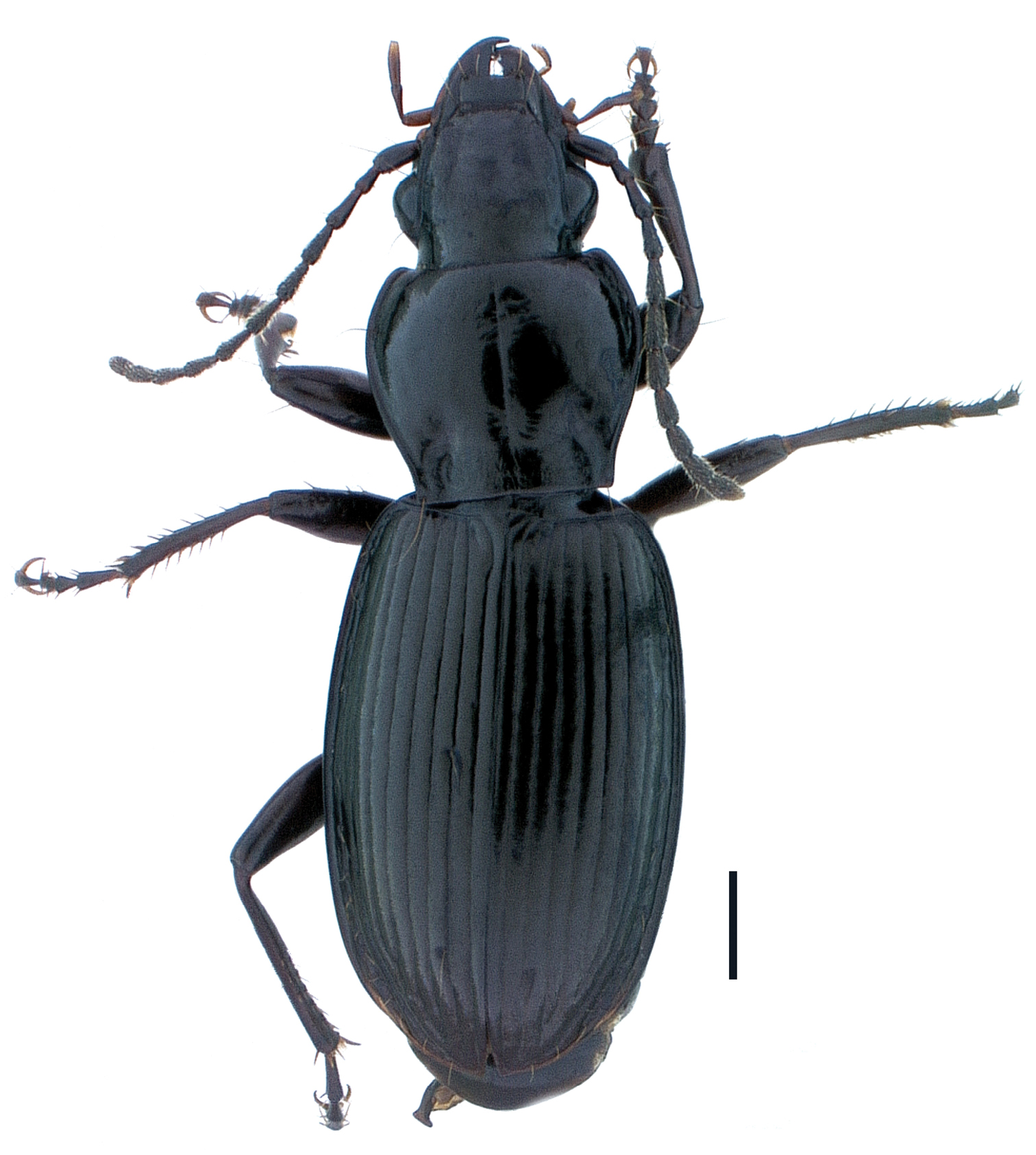
Holotype male, Pterostichus (Pseudoferonina) bousqueti Bergdahl, sp. n., dorsal habitus. Scale line = 1.0 mm. Automontage digital image by D. H. Kavanaugh. (Bergdahl & Kavanaugh, 2011)
The topic of nomenclature for sale arises every now and again, occasionally even making mainstream media. You may recall the story of a recently discovered Australian shrimp, who’s naming rights were auctioned off to the highest bidder on eBay (that bidder turned out to be a professional athlete interested in conservation biology) and the resulting funds donated to marine conservation (McCallum & Poore, 2010). Or perhaps the $650,000 Golden Palace Casino paid to give Callicebus aureipalatii it’s name (that money was also donated to conserving the native habitat of the species).
While the wholesale of species naming rights is relatively uncommon, ask any taxonomist and they’ll likely have an opinion on the subject, often one of caution and fear of abuse. Consider what may happen if the business of species naming becomes as popular as the business of selling star names (which is pretty well a scam by the way; stars aren’t officially named, they’re numbered by the IAU); countless fly-by-night companies splitting the slightest variation to turn a few bucks and causing true taxonomists endless headaches as they deal with an infinite number of synonymies. A pretty simple ruse given the current rules of zoological nomenclature; give a brief description, say you’re depositing the type specimen somewhere, and then provide several public libraries with copies of the descriptions, which don’t even need to be peer-reviewed.
You can see why taxonomists have a vested interest in keeping a close eye on sponsored taxonomy; we have enough true species to find and describe without needing to waste our time dealing with splitting-for-profit names.
While the threat of poor taxonomy is ever present with current ICZN regulations, most taxonomists are extremely underfunded (if funded at all) and would love some extra money to help do their jobs, even if it means providing a patronym.
So why am I bringing up the subject now? Just this week James Bergdahl, an “amateur” taxonomist, posted to the ENTOMO-L email listserv offering the name of a recently discovered ground beetle (Carabidae) for sale. From the email:
The species is a flightless ground-beetle (Coleoptera: Carabidae) in the genus Pterostichus. Adults of the species are primarily black, flightless, and approximately 1 cm in length, and live exclusively along small, forested headwater streams. Similar species have recently been described by Bergdahl & Kavanaugh (2011)*. The species is a member of a closely related group of beetles, restricted in distribution (endemic) to the Pacific Northwest, that have experienced a spectacular radiation across the many coastal and interior mountain ranges of the region.
The minimum offer accepted is estimated to be approximately US$20,000. These funds will be used to support all aspects of wildlife and habitat research by the Conservation Biology Center, including office, travel, lab and publication expenses.
You may think that US$20,000 is a lot of money to ask for naming an obscure, tiny, black beetle, but consider a partial list of the costs associated with taxonomy:
- 15 years of field research to find it (according to the email) – safely assume $500 of expenditures/year (collecting equipment/traps, travel & accommodation costs, etc)
- lab materials for conducting research (pins, drawers, cabinets, microscopes, imaging resources, etc) – $2000+
- publication costs – $250+
- acquisition of taxonomic knowledge necessary to distinguish a new species (literature, museum visits, specimen shipping costs, etc) – priceless
That brings a low end estimate of the cost to describe this species at around $10,000, not including salary and that all-important priceless category, making a $20,000 asking price less incredulous. In fact, it’s been hypothesized that the average cost for describing a species is US$48,500 (Carbayo & Marques, 2011), making this ground beetle a steal of a deal (especially compared to that GoldenPalace.com Monkey)!
While in a perfect world taxonomists wouldn’t need to prostitute their work to pay the bills, if done responsibly, it may be an alternative mode of rectifying the taxonomic impediment.
So if you or someone you know has an extra $20,000 laying around and would like to help a taxonomist disseminate his knowledge, why not contact James and become a part of history?
What do you think of taxonomic funding via patronage? Would you consider paying a taxonomist for the honour of naming a species? Leave a comment below!
![]() Bergdahl, J., & Kavanaugh, D. (2011). Two new species of Pterostichus Bonelli subgenus Pseudoferonina Ball (Coleoptera, Carabidae, Pterostichini) from the mountains of central Idaho, U.S.A. ZooKeys, 104 DOI: 10.3897/zookeys.104.1272 (OPEN ACCESS)
Bergdahl, J., & Kavanaugh, D. (2011). Two new species of Pterostichus Bonelli subgenus Pseudoferonina Ball (Coleoptera, Carabidae, Pterostichini) from the mountains of central Idaho, U.S.A. ZooKeys, 104 DOI: 10.3897/zookeys.104.1272 (OPEN ACCESS)
Carbayo, F., & Marques, A. (2011). The costs of describing the entire animal kingdom Trends in Ecology & Evolution, 26 (4), 154-155 DOI: 10.1016/j.tree.2011.01.004
ANNA W. McCALLUM, & GARY C. B. POORE (2010). Two crested and colourful new species of Lebbeus (Crustacea: Caridea: Hippolytidae) from the continental margin of Western Australia Zootaxa, 2372, 126-137 Preview Here



